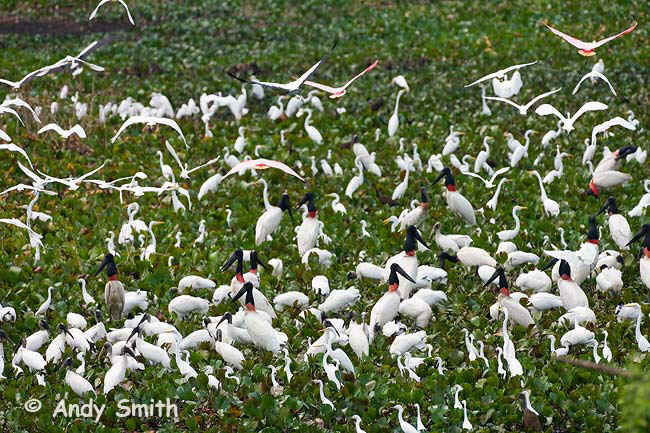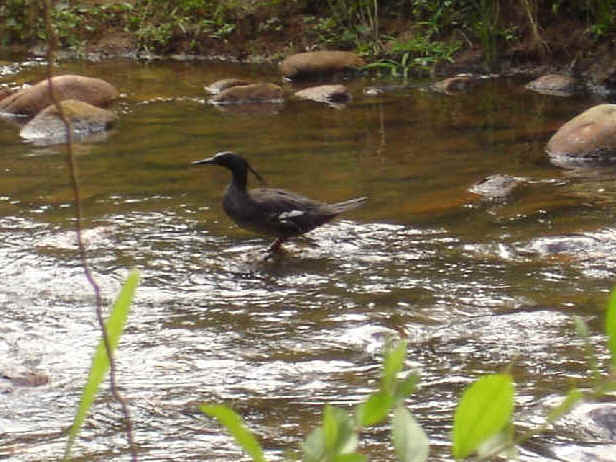
E-mail: font@focusonnature.com
Phone: Toll-free in USA 1-800-721-9986
or 302/529-1876; Fax: 302/529-1085
 |
PO Box 9021,
Wilmington, DE 19809, USA E-mail: font@focusonnature.com Phone: Toll-free in USA 1-800-721-9986 or 302/529-1876; Fax: 302/529-1085 |
THE FONT
BIRDING & NATURE TOUR IN BRAZIL & adjacent PARAGUAY & BOLIVIA
(at Iguacu Falls & in
the Brazilian states of Mato Grosso do Sul & Minas Gerais)
September 2006

Birds in the Pantanal of
Mato Grosso do Sul,
mostly Egrets & Jabiru Storks,
photographed during the FONT September 2006 Brazil Tour
Links:
Photos
of Birds & Animals from our September 2006 Brazil Tour
Birds & Other
Wildlife during our Brazil Tour - September '06
Cumulative List of Birds during our Brazil Tours - Part 1 (Greater Rhea thru Eastern Streamcreeper)
Cumulative
List of Birds during our Brazil Tours - Part 2 (Fasciated
Antshrike thru Hooded Siskin)
Upcoming FONT Birding & Nature Tours in Brazil
The following written by Armas Hill, leader
of the tour:
Although this tour would take us
into 3 South American countries, it was mostly, by far, in Brazil.
There's certainly no doubt about it - Brazil is a great place for birding, which
is why our September 3-17, 2006 tour there
was our 39th in that country.
During the tour, we visited 3 distinctly different areas. Firstly, we went to
Iguazu Falls, in southern Brazil by the border with Argentina & Paraguay.
The falls itself is spectacular, and the national park on the Brazilian side of
the river is a wonderful place, with nice forest that's good for both BIRDS and
BUTTERFLIES.
As we were in the area, one afternoon we visited Paraguay to see
what nature (particularly birds) we'd see there. The hummingbird known as the
BLACK JACOBIN there was a bit of a surprise for us (at the far western edge of
its range). The hummingbird known as the GILDED SAPPHIRE was the only one we'd
see during the entire tour, and, oddly, another "exclusive" for us in
Paraguay was the colorful YELLOW-FRONTED WOODPECKER, a species we often see in
southeastern Brazil. Colorful, yes, as it's not just yellow, but also with
bright red, and black and white. It's in the same genus as the Acorn Woodpecker
of North America.
The second area of Brazil that we visited is one of best regions in all of South
America for the observation of nature - the area of the Pantanal in the
Brazilian state of Mato Grosso do Sul. We stayed at two places in that area,
each a bit different from the other in terms of setting and habitat, and
therefore each with some different birds. Both, however, had wildlife just
outside the doors of where we slept and ate. Also outside those doors, birds ate
too, often in large numbers, especially in the morning coming to feed put on
trays for them. At one place, there were dozens of BLACK-HOODED, or NANDAY,
PARAKEETS. At both places, there were DOVES (as many as 7 species) including the
LONG-TAILED GROUND-DOVE, a bird, it could be said, to be "of the Pantanal".
There were 2 species of CARDINALS, the RED-CRESTED and the more-common
YELLOW-BILLED (also, by the way, with a red head, and with a bill that usually
appears more orange than red). There were also numbers of bright yellow SAFFRON
FINCHES. And, at the feeders, as well, were SAYACA TANAGERS, with their soft
blue hue (a cousin of the Blue-gray Tanager), along with an assortment of
FLYCATCHERS, SALTATORS, THRUSHES, and even CARACARAS outside those doors.

Black-hooded (or Nanday)
Parakeets,
coming to lunch outside where we had ours in the Pantanal
That
part of the Pantanal is not far from the border with Bolivia, and so one
afternoon we visited that country, where mostly by a large lake, we saw a nice
number of birds. Nice to see was a flock of about 15 NACUNDA NIGHTHAWKS that
rose up at about 5 in the afternoon, from a grassy island, to fly about. They
had been roosting on that island during most of the day. Also nice for us in
Bolivia were 2 APLOMADO FALCONS perched side by side.
And then, the third area of the tour was in the interior of southeastern Brazil, in the
state of Minas Gerais, a place known for mining and gems, and historic cities in
the hills. The most famous of them is Ouro Preto, with cobblestone streets and
many churches. A reason why we chose this to be the third region for our
September '06 Tour was because, for birding, it's very "Brazilian".
Whereas the other areas were near borders, Minas Gerais is a place, on the other
hand, where a number of birds endemic to Brazil can be found. It's a good place
for specialties and also for some rarities. Foremost among the latter, for us,
was the BRAZILIAN MERGANSER. It is, in fact, one of the rarest birds in the
world, with an estimated total population of less than 200 birds. We saw a pair
of them, nicely, in a telescope, gray and green, blending in against gray rocks
along a riverside. This was the 5th FONT tour during which we'd seen the BRAZILIAN
MERGANSER, or "PATO MERGULHAO", since 1997. 50 years before that the
bird was thought to be extinct. It was re-found in 1948. Seeing the BRAZILIAN
MERGANSER, as we did, was certainly one of the highlights of our September '06
Tour.
But the merganser was not the only highlight. When a tour is in the Brazilian Pantanal,
there are undoubtedly other highlights too. Nor was the merganser the only rarity.
In the Pantanal, there's also the HYACINTH MACAW. Actually, we saw ours, during
the Sept '06 tour, rather unexpectedly prior to being in the Pantanal, by a
large rocky hill. 2 HYACINTH MACAWS were perched in a large cliffside hole. In
that area, during previous tours, we've seen Red-and-green Macaws. Just a mile
or so down the road, after our first Hyacinth pair, we saw another, closer to
us, perched in a tree.
The HYACINTH MACAW is the largest member of the parrot family, anywhere in the
world. In Brazil, yes, a large country, and the largest in South
America, there are some other birds, that we also saw in the
"largest" category. The TOCO TOUCAN is the largest of that tribe. The
GREATER RHEA is the largest American bird. It is flightless. Standing almost as
tall, the JABIRU is the largest American stork. Over 5 feet tall, it is big. We
saw many JABIRUS. And many other birds too (EGRETS, IBISES, STORKS, SPOONBILLS,
and others) congregated at dwindling waterholes in the Pantanal during the dry
season, as it was in September.
I noted earlier that in the area of the Pantanal, in Mato Grosso do Sul, we
stayed at two places. And I said that both were in various ways different from
each other. Both, certainly, were great places to visit. But at one of the
places, the excursions that we took in open vehicles, throughout the vast
property, were great. During the day, we traveled in such a way through
extensive rice-fields, and then into other habitats, along channels, and by
edges of fields with scattered trees and sometimes by dense forest. At night, we
also did such excursions - on two consecutive nights. They were simply put,
absolutely superb!
During one of those two nights, we saw a JAGUAR. It was a fair distance away,
but in our binoculars we could see the spots, the ears, the large head, and its
face as it looked at us. When it arose, in the mist, the cat steadfastly just
walked away. It was an image not ever to be forgotten. Some of the other animals
we saw that night would run into the distance. The fearless JAGUAR did not.
In addition to the JAGUAR, other animals that we saw on the open-vehicle
excursions during those two consecutive nights were:
7 OCELOTS (*)
a PANTANAL CAT (*) (formerly considered part of the more-southerly PAMPAS CAT)
a MANED WOLF (*)
2 BRAZILIAN TAPIRS
3 GIANT ANTEATERS
CRAB-EATING FOXES (*)
CRAB-EATING RACCOONS (*)
about a dozen MARSH DEER (*)
a TAPITI (or BRAZILIAN RABBIT)
and many CAPYBARAS.
Not only animals were seen during those nocturnal excursions. We also saw,
nicely, STRIPED OWL (*) and BARN OWL (*), and a large number of NIGHTJARS
including: SCISSOR-TAILED NIGHTJAR (*), LITTLE NIGHTJAR (*), and PAURAQUE.
Additionally, we heard RUFOUS NIGHTJARS and GRAY (formerly called COMMON) POTOOS.
The call of the former is rather like that of a Chuck-Will's-Widow. The call of
the latter is one of the most beautiful sounds in nature.
During the tour, we were fortunate to have with us a talented photographer, who
took excellent photographs of many of the animals and nocturnal birds just
mentioned. Photographs of those with an (*) are elsewhere in the FONT
website:
Photos
of Birds & Animals from our Sep '06 Brazil Tour
Also elsewhere in this website in the feature relating to "South
American Mammals", there are photos of the MARSH DEER and CAPYBARAS,
and
also during the tour, those of BLACK HOWLER MONKEYS. Other animals that we
saw during the Sept '06 Brazil Tour included: GIANT OTTER, both RED and BROWN
BROCKET DEER, AZARA'S AGOUTI, SOUTH AMERICAN COATI, the BLACK-STRIPED TUFTED
CAPUCHIN (MONKEY), the MASKED TITI (MONKEY), the BUFFY-HEADED MARMOSET, and the
BRAZILIAN SQUIRREL and BRAZILIAN GUINEA-PIG.
Fine photographs of birds, taken during the FONT September '06 Brazil Tour, now
in our website, include those of:
HYACINTH MACAW
BLUE-AND-YELLOW MACAW
PLUMBEOUS IBIS
BUFF-NECKED IBIS
SAVANNA HAWK
PALE-CRESTED WOODPECKER
CRIMSON-CRESTED WOODPECKER
WHITE WOODPECKER
RED-BILLED SCYTHEBILL
NARROW-BILLED WOODCREEPER
RUFOUS-TAILED JACAMAR
AMERICAN PYGMY KINGFISHER
AMAZON KINGFISHER
BLACK-HOODED PARAKEETS
GRAY-NECKED WOOD-RAIL
RUFOUS HORNERO at its nest
BLACK-CAPPED DONACOBIOUS
GREAT ANTSHRIKE
SILVER-BEAKED TANAGER
YELLOW-BILLED CARDINAL
ORANGE-BACKED TROUPIAL
WHITE-BELLIED SEEDEATER
WHITE-BROWED BLACKBIRD
Again, these are reached from the link in the feature box on the home-page.
In all, over 380 species of birds were found during our September '06 tour in
Brazil. A complete listing of them is in our website under 2006 Previous Tour
Highlights.
Among the nearly 400 birds during our September '06 Brazil Tour, there are still
a few, not yet mentioned here, that should be.
Before we saw the Brazilian Merganser, in Minas Gerais, we were fortunate to see
both a CROWNED SOLITARY-EAGLE and an ORNATE HAWK-EAGLE fly above us. A few days
earlier, in another part of Minas Gerais, we were fortunate to see a MANTLED HAWK
circling about in the sky. On the ground, a number of times in Minas Gerais, we
enjoyed watching RED-LEGGED SERIEMAS (odd creatures to say the least). Some
other notable sightings in Minas Gerais included these:
on a treetop near Ouro Preto, a SWALLOW-TAILED COTINGA (a beautiful bird),
at a marsh, the striking burgundy and beige-colored bird with a long tail,
called the STREAMER-TAILED TYRANT,
by a stream, a nice look at a SHARP-TAILED STEAMCREEPER (imagine, they wanted
us to call that bird the STREAMSIDE LOCHMIAS),
on a forest floor, another nice look at certainly a dapper little bird, the
RUFOUS GNATEATER,
in trees, in another forest, high in the hills above a belt of coffee groves,
birds such as the GIANT ANTSHRIKE (that it is), and the brilliantly-blue
DIADEMED TANAGER. Just a few miles back down the road, also brilliantly-blue
male SWALLOW-TAILED MANAKINS were performing at their lek.
At yet another Minas Gerais location, where we stopped for a sandwich for lunch,
a bird not often seen, a GREEN-CHINNED EUPHONIA, also came by to eat, at a feeding
tray.
These were some of the birds during the last few days of the tour.
During the
first few days, in the area of Iguazu Falls (which we already referred to as
"spectacular"), there were yet some other birds worth noting.
Over the
river above the falls, there were at least a few dozen SNAIL KITES flying about
above the water and landing on the small rocky islands. We've been to Iguazu over 10
times during previous FONT tours in Brazil and Argentina, but, prior to this
tour, we had never seen SNAIL KITES there.
GREAT DUSKY SWIFTS were at the falls, but not as many as there could be (or have
been for us in the past).
During one of our mornings at Iguazu, a tree bare of leaves was, however, filled
with color. It was filled with EUPHONIAS in brilliant plumage, mostly VIOLACEOUS,
feeding on berries. The also-colorful BLUE-NAPED CHLOROPHONIA was there as well,
along with the CHESTNUT-BELLIED EUPHONIA (also a looker!) Across the road, a
white bird with a blue throat that's a member of the cotinga family, was calling
loudly - a BARE-THROATED BELLBIRD.
Among trees in the forest, that morning, at one time we were surrounded by
ANTBIRDS with other birds in a mixed flock. There were both STREAK-CAPPED
and RUFOUS-WINGED ANTWRENS, BERTONI'S ANTBIRD, and PLAIN ANTVIREO. In the
distance, a SHORT-TAILED ANTTHRUSH was calling.
One of our most interesting bird sightings at Iguazu was when the head of a
BLOND-CRESTED WOODPECKER appeared out of a treehole, at eye-level. It looked at
us. And we looked at it, of course!
That woodpecker was just one of the nice encounters we had with birds, and
other nature, during our September '06 Brazilian Tour, in the areas of Iguazu,
Mato Grosso do Sul (the Pantanal), and Minas Gerais. We look forward to more
such encounters when we return to Brazil in 2007.
The birds voted by the participants, following the tour, as the "Top
Birds" were:
1 - Brazilian Merganser (p)
2 - Streamer-tailed Tyrant
3 - Red-legged Seriema
4 - Black-breasted Plovercrest
5 - Pale-crested Woodpecker (p)
6 - Red-billed Scythebill (p)
7 - Spotted Nothura
8 - Striped Owl (p)
9 - Scissor-tailed Nightjar (p)
10 - Toco Toucan
11 - Swallow-tailed Hummingbird
12 - Blond-crested Woodpecker
Photographs of those birds noted with a (p) are elsewhere in this website in our
NEOTROPICAL BIRD PHOTO GALLERY.
That of the #1 bird, the Brazilian Merganser, is also
below.

The very rare Brazilian Merganser in Minas
Gerais, 2006.
A pair was seen during the FONT September '06 tour.
(photo courtesy of Renilda Dupin)